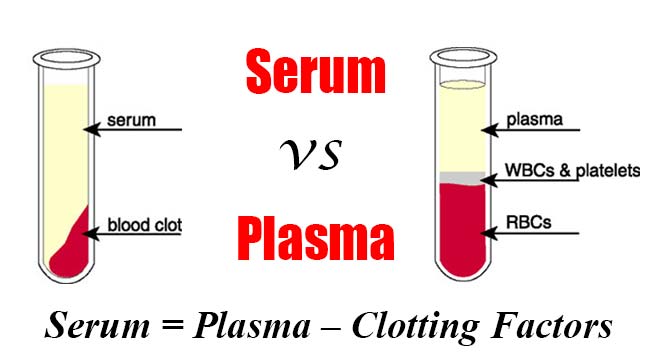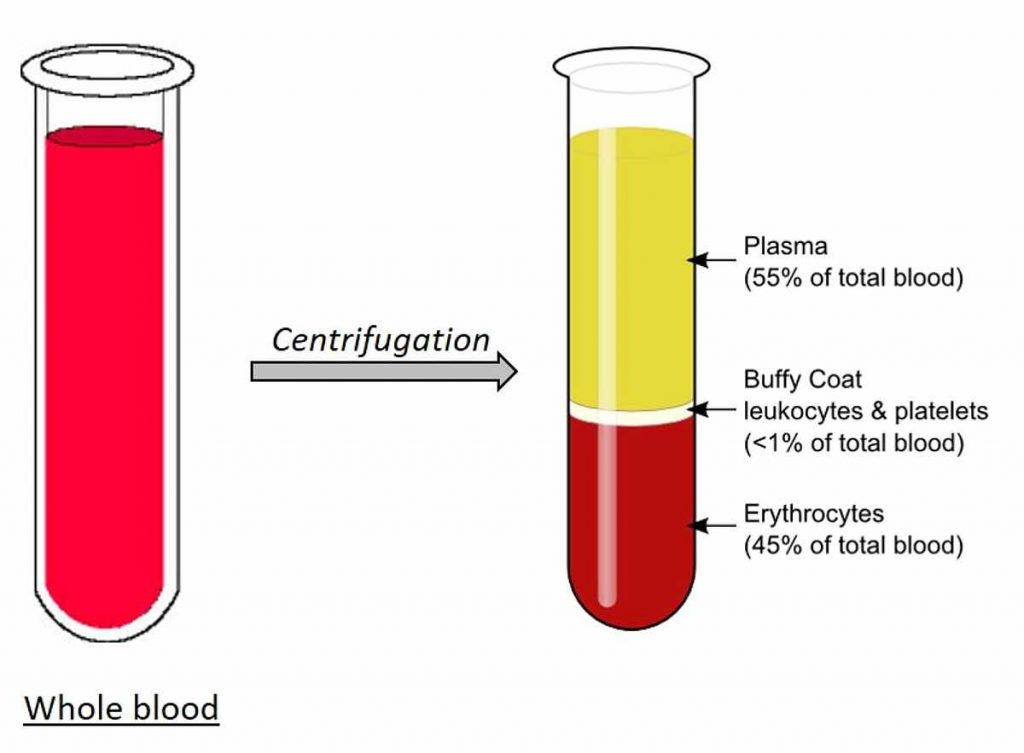What is Plasma in Blood?
Plasma is the liquid portion of blood. About 55% of our blood is plasma, and the remaining 45% are red blood cells, white blood cells and platelets that are suspended in the plasma.
Plasma is about 92% water. It also contains 7% vital proteins such as albumin, gamma globulin and anti-hemophilic factor, and 1% mineral salts, sugars, fats, hormones and vitamins.
Plasma is the largest part of your blood. When separated from the rest of the blood, plasma is a light yellow liquid. Main role of plasma is to take nutrients, hormones and proteins to the part of the body that need it. Cells also put their waste products into the plasma. The plasma then helps remove this waste from the body. Blood plasma also carries all parts of the blood through your circulatory system.
The most important thing is that we added the centrifugation was the anticoagulant like heparin and EDTA, which is used to avoid clotting to get plasma in the liquid state.
Plasma serves four important functions in our bodies:
1. Helps maintain blood pressure and volume.
2. Supply critical proteins for blood clotting and immunity.
3. Carries electrolytes such as sodium and potassium to our muscles.
4. Helps to maintain a proper pH balance in the body, which supports cell function.
What is Blood Plasma Used For?
Plasma is commonly given to trauma, burn and shock patients, as well as people with severe liver disease or multiple clotting factor deficiencies. It helps boost the patient’s blood volume, which can prevent shock, and helps with blood clotting. Pharmaceutical companies use plasma to make treatments for conditions such as immune deficiencies and bleeding disorders.
What is a Plasma Donation?
If you want to donate plasma to help others in need, you will go through a screening process. This is to make sure your blood is healthy and safe. If you qualify as a plasma donor, you’ll spend about an hour and a half at a clinic on every follow-up visit.
During the actual blood donation process, your blood is drawn through a needle placed in a vein in one arm. A special machine separates the plasma and often the platelets from your blood sample. This process is called plasmapheresis. The remaining red blood cells and other blood components are then returned to your body, along with a little saline (salt) solution.
Donated plasma is frozen within 24 hours of being donated to preserve its valuable clotting factors. It can be stored for up to one year and thawed for transfusion to a patient when needed.
Who Should Donate Plasma?
People with type AB blood to consider a plasma donation. AB is the only universal plasma and can be given to patients of any blood type. This means that type AB plasma transfusions can be given immediately, without losing precious time determining if the patient’s blood type is compatible. In emergency medicine, such as caring for a major trauma or burn patient, time saved can mean the difference between life and death.
What is serum?
Serum, the portion of plasma remaining after coagulation of blood, during which process the plasma protien fibrinogen is converted to fibrin and remains behind in the clot. It is the fluid part of the blood and does not contain the blood clotting factor or blood cells. It is the resources for proteins, antigens, antibodies, electrolytes and hormones. It is helpful in diagnosing the diseases such as cholesterol, sugar, blood pressure, etc., and also in blood typing.
Serum = plasma – clotting factors (fibrinogen)
Why is the serum test conducted?
The serum is done to measure the amount of protein albumin in the blood. When the kidney starts to fail, the albumin starts leaking in the urine. The serum test helps to diagnose liver and kidney abnormalities.
Difference between plasma and serum
| S.N. | Characteristics | Serum | Plasma |
| 1. | Definition | The clear yellow fluid separated when blood is allowed to clot freely. | Yellowish and slight alkaline fluid, in which blood cells float. |
| 2. | Clotting factors | It is the watery fluid from blood without the clotting factors. | It is the blood fluid that contains blood-clotting agents. |
| 3. | Composition | The serum contains proteins, electrolytes, antibodies, antigens, and hormones. | It contains all suspended blood cells with proteins, salts, lipids, glucose. |
| 4. | Water content | The serum contains 90% water. | Plasma contains 92-95% of water. |
| 5. | Components | The serum contains proteins like albumin and globulins. | Plasma contains clotting factors and water. |
| 6. | Fibrinogen | Fibrinogen absent. | Fibrinogen present. |
| 7. | Cell arrangement | Cells are usually attached together by clot formation. | Cells are not attached together and suspended in plasma. |
| 8. | Method of Separation | Acquired from the process of spinning after clotting. | Acquired from the process of spinning before clotting. |
| 9. | Use of Anti-coagulant | Anticoagulant is not needed to separate the serum. | Anticoagulant is required to obtain plasma. |
| 10. | Feasibility of Separation | Separation of serum requires higher levels of expertise, expenses and is time-consuming. | Separation of plasma is relatively easy and inexpensive |
| 11. | Volume in blood | Less volume in comparison to plasma. | Consists of 55% of the total volume of blood. |
| 12. | Density | The density of serum is 1.024g/ml. | The density of plasma is 1.025g/ml. |
| 13. | Storage | The serum can be stored at 2-6 degrees centigrade for several days. | Frozen plasma can be stored for up to a year. |
| 14. | Discoloration | The serum does not discolor on standing. | Plasma tends to discolor on standing. |
| 15. | Importance | The serum is the primary source of electrolytes. | The function of the plasma is the transport of excretory metabolites and materials in the blood. It also helps in the maintenance of blood pressure and in the regulation of body temperature. |
| 16. | Associated terms | The branch of study that deals with studying serum and analyzing it for diagnostic purposes are called serology. | Plasmapheresis refers to the process of isolation of plasma from the blood using centrifugation. |
| 17. | Uses | Human serum is usually used for the purpose of diagnostic testing. Other animal seras are used as anti-venom, antitoxins, and vaccinations. They are also used in humans for therapeutic purposes. | Plasma is delivered to the patients who lack blood cells. It is also Transferred to patients who suffer from hemophilia, shocks, burns, and other clotting problems. |
Similarities between plasma and serum
- Both serum and plasma are the components of blood.
- Both serum and plasma are used for blood testing for diagnostic purpose.
- Both are the fluid component of blood.
- The composition plasma and serum is more or less similar.
Both contain hormones, glucose and electrolytes.























